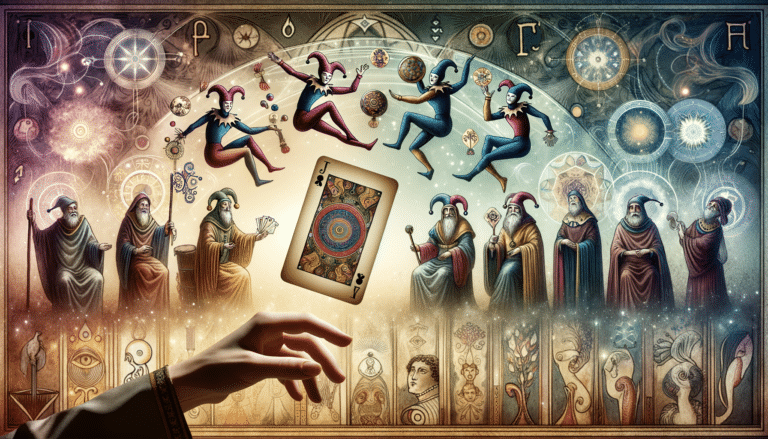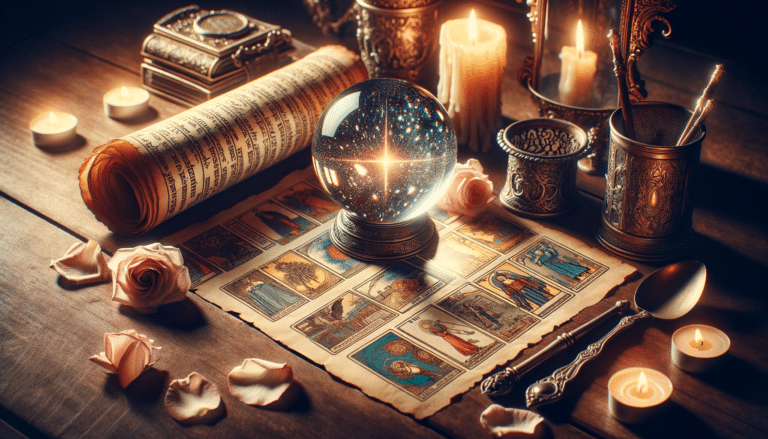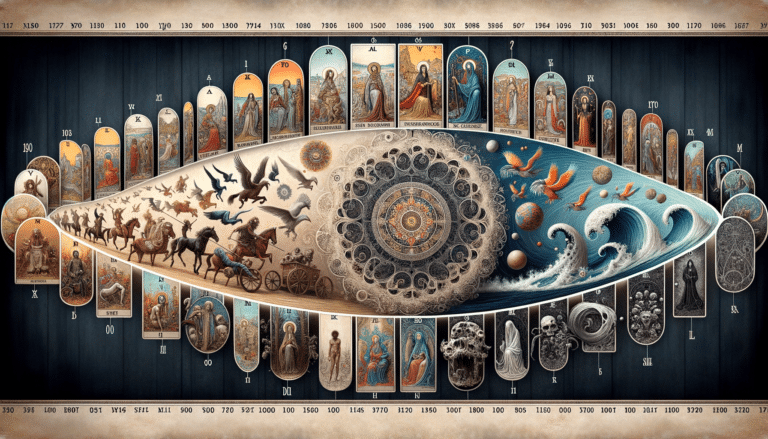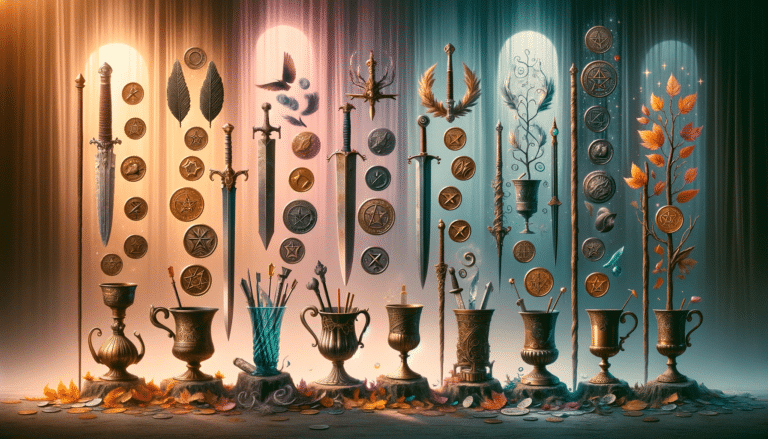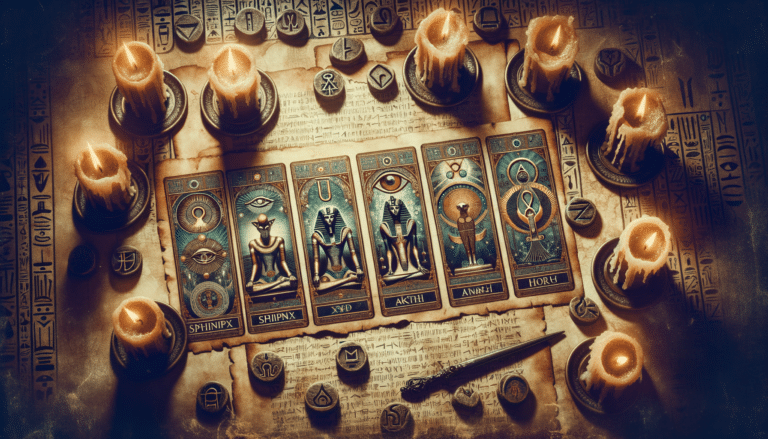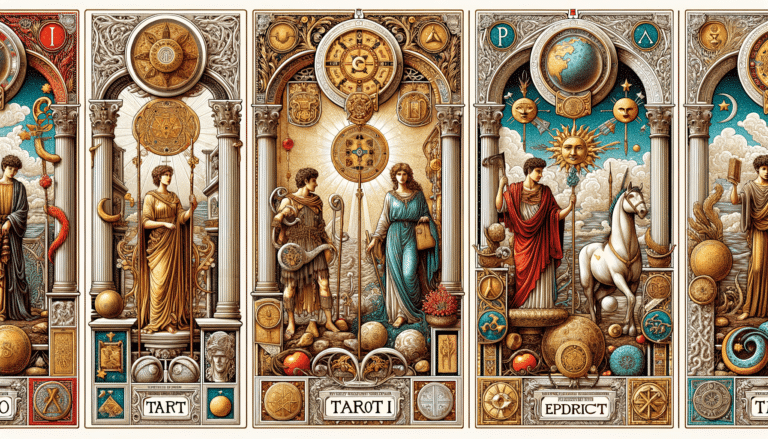Mysticism and Tarot A Historical Perspective on Influence
Tarot’s evolution has been fed by the streams of mysticism throughout history.
You’re stepping into a world where the origins of tarot cards blend with the rise of Hermeticism, a philosophy that infuses the cards with deeper esoteric meaning.
As you delve deeper, you’ll discover the Kabbalah’s intricate web woven into the tarot’s very fabric during the Renaissance, a time teeming with occult exploration.
Theosophy’s late arrival on the scene spurred a revival, breathing new life into tarot’s mystical connections.
Now, modern tarot reflects a tapestry of these mystical trends, offering you not just a tool for divination, but a mirror reflecting humanity’s enduring quest for knowledge beyond the tangible.
Key Takeaways
- Tarot cards originated as playing cards before evolving into tools of divination through mysticism.
- Hermeticism, Kabbalah, Neoplatonism, and Gnostic traditions played significant roles in infusing tarot with mystical meaning and symbolism.
- Theosophy, particularly the influence of the Theosophical Society, helped revive interest in tarot and shifted its perception from a game to a method for self-exploration and accessing higher knowledge.
- Modern tarot continues to be influenced by various mystical traditions and trends, incorporating symbols and themes from New Age practices, pagan resurgence, and Eastern philosophies.
Origins of Tarot Cards
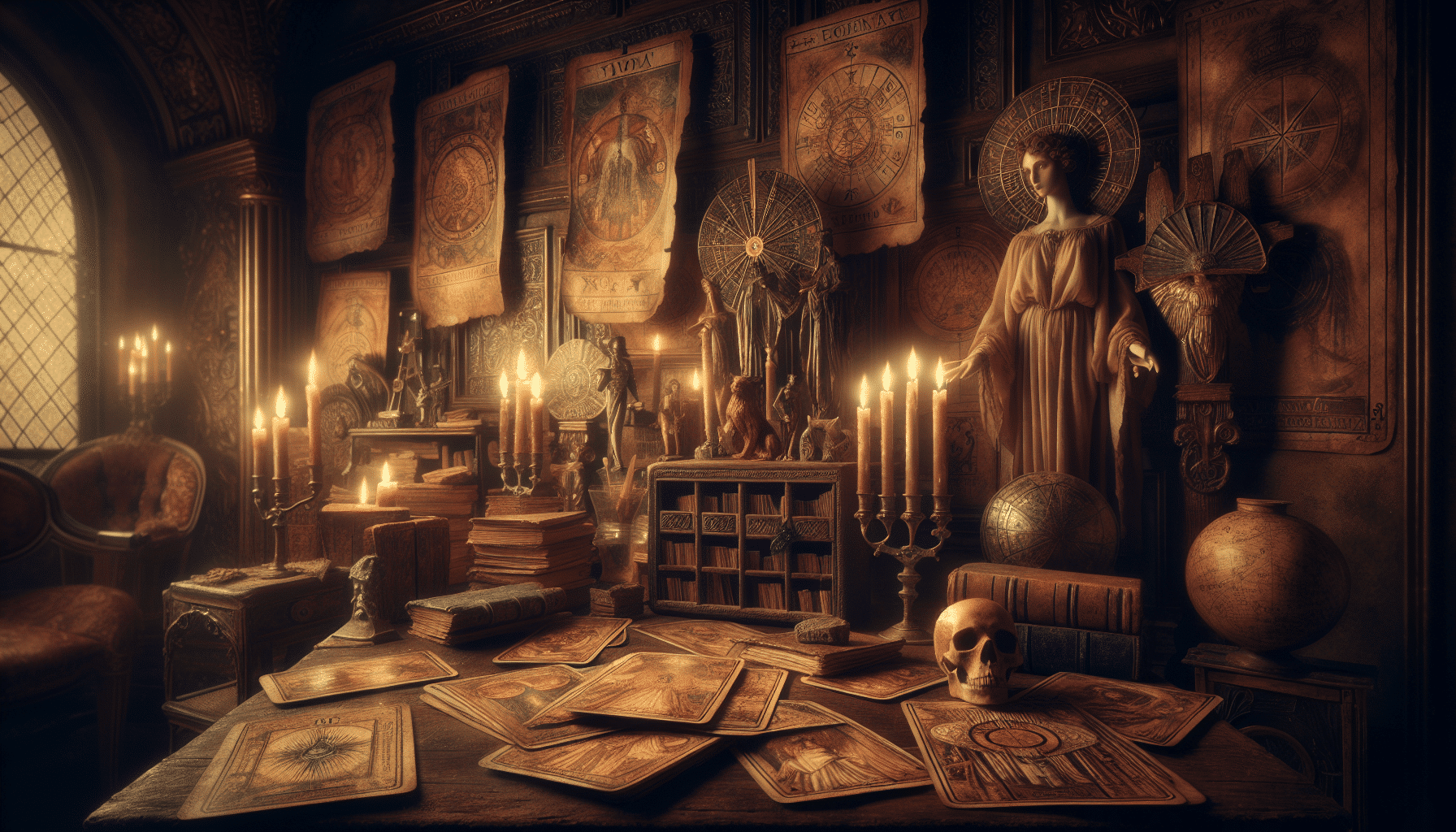
Tarot cards, which you might associate with fortune-telling, actually originated in the 15th century as a form of playing cards. This was long before they became tools of divination. Back then, you’d have found them in the hands of Italian nobles, who enjoyed a game called tarocchi.
It wasn’t until centuries later that the mystical shift occurred, transforming these cards into a means for cardomancy origins to unfold.
As playing cards adaptation took root across Europe, tarot imagery became richer and more symbolic. You see, tarot picked up layers of esoteric meaning as it passed through cultures. Each artist and mystic contributed their insights, embedding ancient wisdom into the intricate designs. By the 18th century, tarot was embraced by occultists who believed the cards held the keys to understanding life’s mysteries.
You’re now part of a long tradition of seekers whenever you shuffle a tarot deck. The cards reflect a tapestry of human experience, colored by historical adaptations and mystical reinventions. They’re not just cards; they’re mirrors to the soul, thanks to the curious blend of card game origins and spiritual seeking.
The Rise of Hermeticism
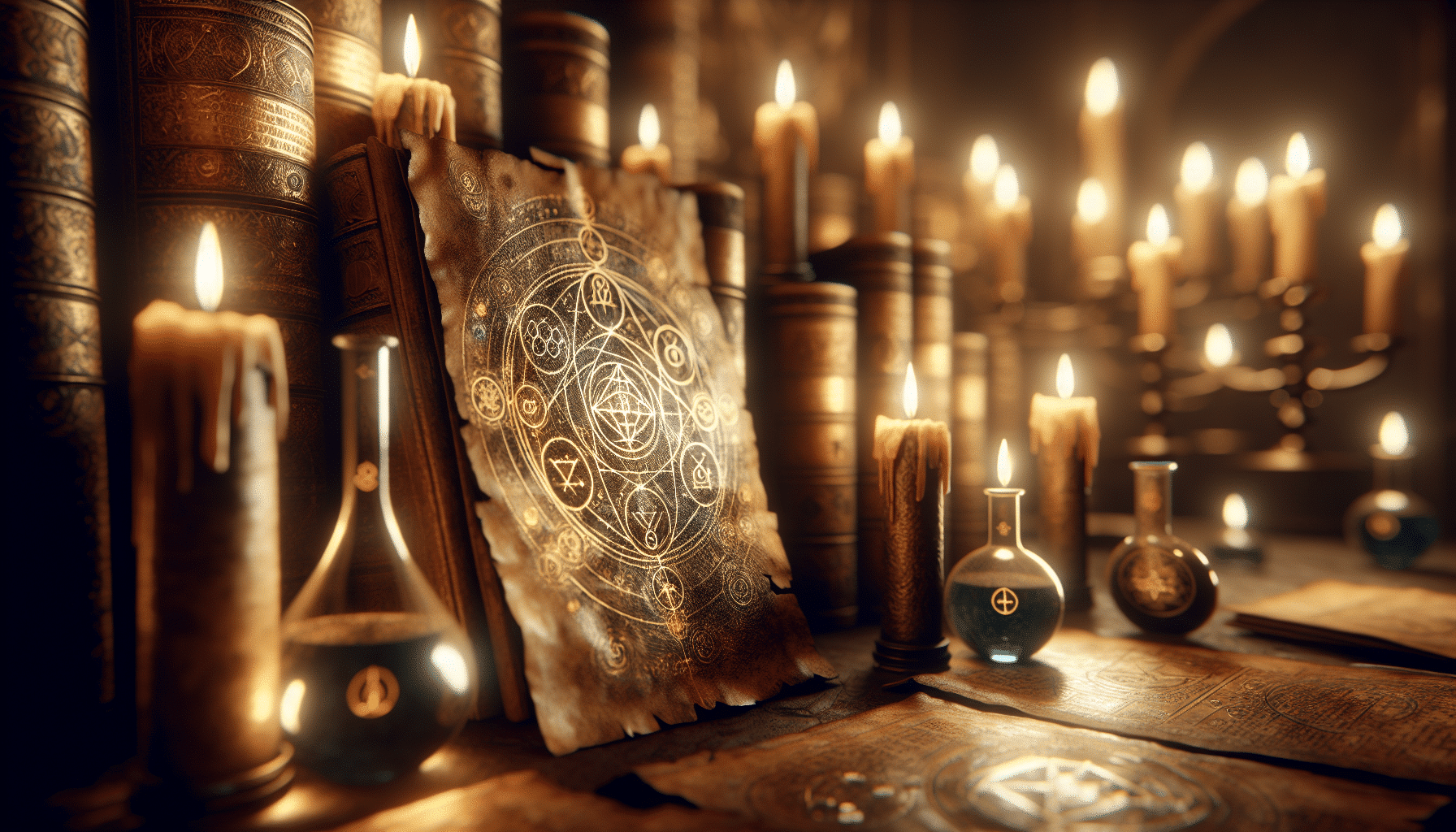
During the Renaissance, you’ll find that Hermeticism played a pivotal role in infusing tarot with its mystical elements. This philosophical system, drawing from Gnostic traditions and Esoteric Christianity, intertwined with the art of tarot, layering it with symbolic depth and spiritual significance. You might wonder how this blend influenced the cards’ design and interpretation. Well, it introduced themes of alchemy, astrology, and theurgy, which are practices deeply rooted in Hermetic principles.
As tarot evolved, it wasn’t just a game anymore; it became a tool for personal enlightenment and a mirror reflecting the universal and the divine. You’ll see that the cards themselves started to hold more meaning than their face value, each one representing a complex web of ancient knowledge and Hermetic wisdom.
Here’s a table that captures key elements of Hermeticism and how they connect to tarot:
| Hermetic Principle | Connection to Tarot |
|---|---|
| As Above, So Below | The mirroring of cosmic truths in personal experiences |
| Alchemical Transformation | The journey of the Fool towards self-realization |
| Astrological Correspondences | The association of cards with celestial bodies |
| Theurgy | Using the cards for spiritual upliftment |
| Gnosis | The pursuit of esoteric knowledge through the cards |
Understanding these connections enriches your appreciation for tarot’s intricate tapestry, weaving together the mystical and the mundane.
Check out our Tarot Cards & Oracle Decks here…
Kabbalah and Tarot Integration
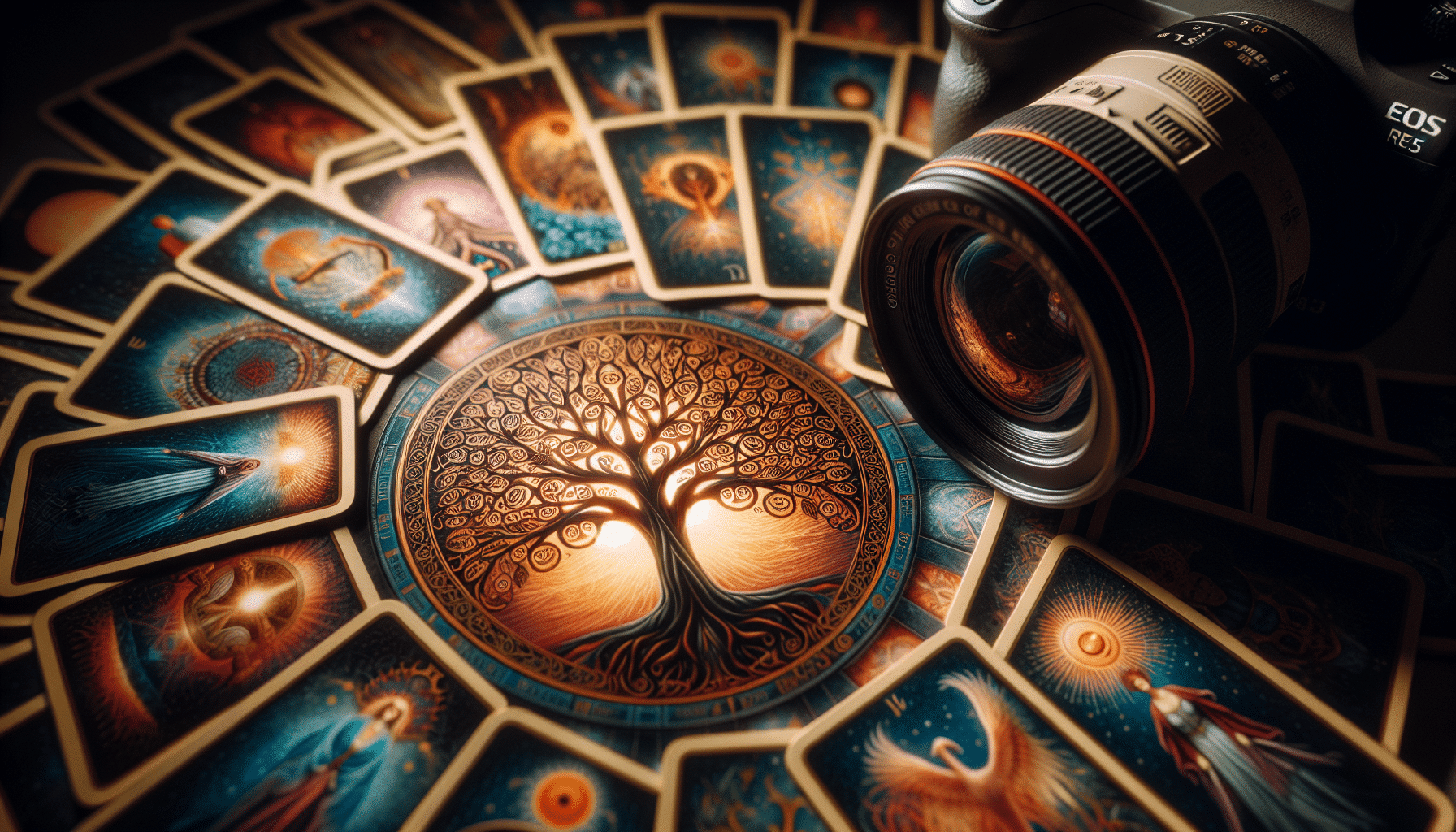
As you delve deeper into tarot’s mystical roots, you’ll encounter the profound influence of Kabbalah, an esoteric Jewish tradition that further shaped the spiritual dimensions of the cards. Kabbalah introduces a complex framework of Divine archetypes and arcane correspondences, which many tarot enthusiasts find mirrors the symbolism inherent in the tarot deck.
The Tarot’s integration with Kabbalah is particularly evident in the Major Arcana, where each card can be associated with the paths on the Kabbalistic Tree of Life. This tree represents the journey of spiritual ascent, mapping the soul’s path towards enlightenment. The tarot’s archetypal figures, from The Fool to The World, are seen as stages of this journey, embodying the lessons and challenges one faces along the way.
You’ll notice that the Minor Arcana also has Kabbalistic connections. Each suit corresponds to one of the four worlds in Kabbalistic thought, and every card can relate to the sephirot, or spheres, on the Tree of Life, which symbolize different attributes of God. By understanding these correspondences, you can deepen your readings, gaining insights into the complex interplay between the material and spiritual worlds.
Embracing the Kabbalah’s insights won’t just give your tarot practice a historical context – it’ll also enrich the narratives you create, allowing you to tap into a more profound well of meaning.
Learn more with these tarot books here…
Renaissance Occult Philosophies
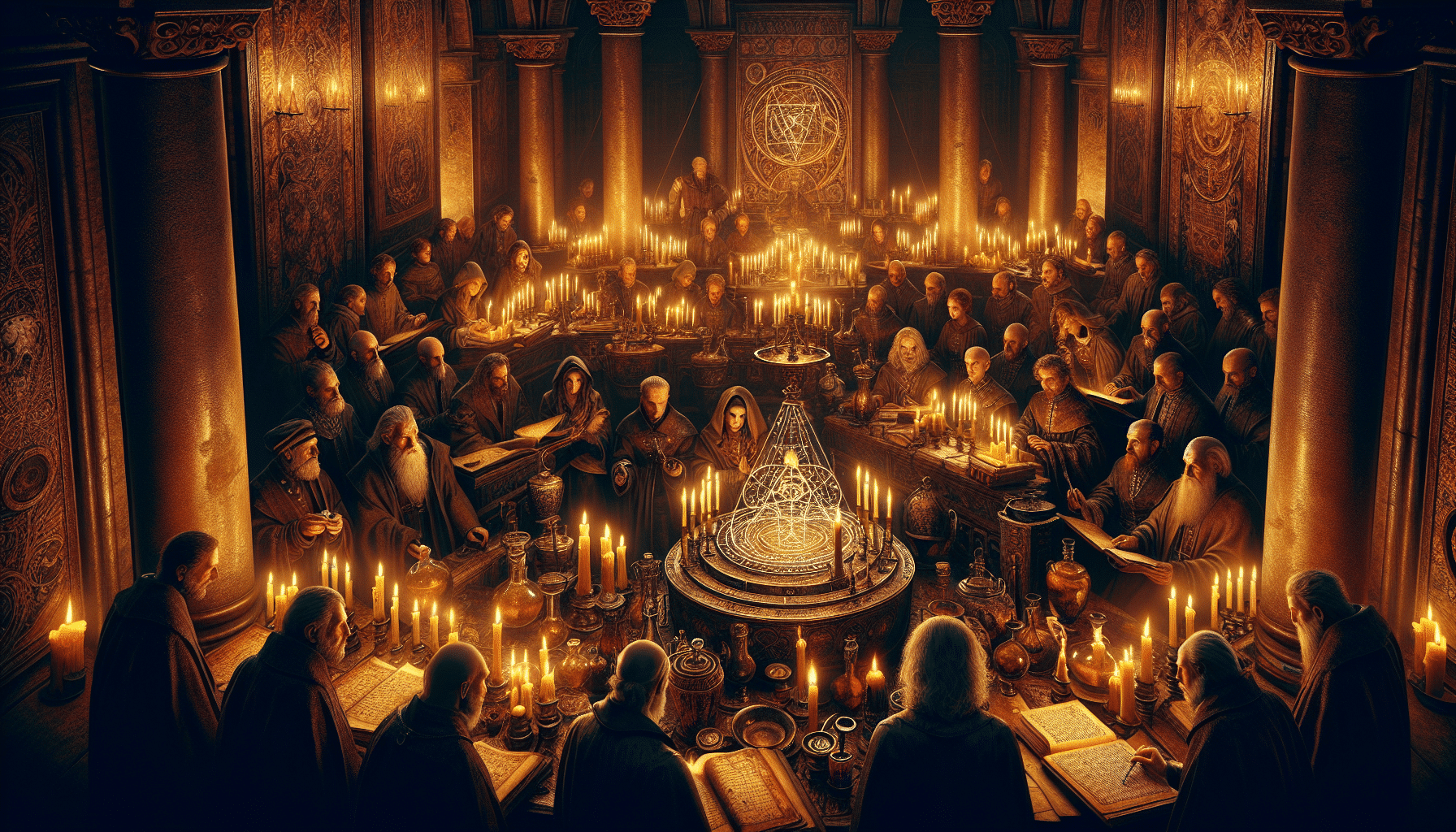
As you explore the tapestry of Tarot’s past, you’ll see Hermeticism’s profound impact on its symbols and meanings. Alchemical imagery didn’t just embellish the cards; it wove deep layers of transformational symbolism into them.
Neoplatonism, too, left its mark, infusing the deck with philosophical concepts that challenge the seeker to look beyond the material world.
Hermeticism’s Impact
You’ll find that the Renaissance era’s embracement of Hermeticism – a set of philosophical and esoteric beliefs based on the writings attributed to Hermes Trismegistus – profoundly shaped the symbols and interpretations of Tarot cards.
This period witnessed a resurgence in mystical thought, blending Gnostic traditions with astrological correspondences. Hermeticism emphasized the notion of ‘as above, so below’, suggesting a microcosm-macrocosm relationship that Tarot practitioners incorporated into their art.
Each card began to hold not just a picture or a number but a complex array of meanings connected to the cosmos and human spirituality. Hermetic themes wove through the Tarot, turning it into a tool for divination and self-discovery, rich with layers of occult significance waiting to be unlocked by those who sought deeper understanding.
Alchemy Symbolism Integration
Within the tapestry of Tarot’s evolution, alchemical symbolism emerged, intertwining Renaissance occult philosophies with the cards’ intricate imagery and meanings. You’ll find that the Tarot deck isn’t just a tool for divination; it’s a repository of profound wisdom.
The integration of alchemy brought symbolic transmutation to the forefront, where each card’s illustration could represent a step in the alchemist’s journey towards enlightenment and the perfection of the soul.
This was no mere coincidence. Esoteric elements were deliberately woven into the Tarot to create a syncretic system of knowledge. As you delve deeper into the cards, you’ll notice that the symbols aren’t random; they’re carefully chosen to reflect transformative processes, both spiritual and material, echoing the alchemists’ quest for the Philosopher’s Stone.
Neoplatonism and Symbolism
In exploring the Tarot’s mystical roots, you’ll encounter Neoplatonism, a philosophy that, during the Renaissance, profoundly influenced the cards’ symbolic narratives with its emphasis on spiritual ascent and the unity of all existence. This system interwove Gnostic influences and Divine archetypes, embedding them into the Tarot’s imagery.
Here’s a table highlighting the emotional impact of these concepts:
| Concept | Emotional Resonance |
|---|---|
| Spiritual Ascent | Hope and inspiration |
| Unity of Existence | Comfort in interconnection |
| Gnostic Influences | Awe for hidden knowledge |
| Divine Archetypes | Reverence for universal patterns |
| Symbolic Narratives | Curiosity and personal reflection |
These elements combined to make the Tarot a mirror of the soul’s journey towards enlightenment, offering not just predictions but a path to self-understanding.
Learn even more secrets of tarot history here…
Theosophy and Tarot Revival
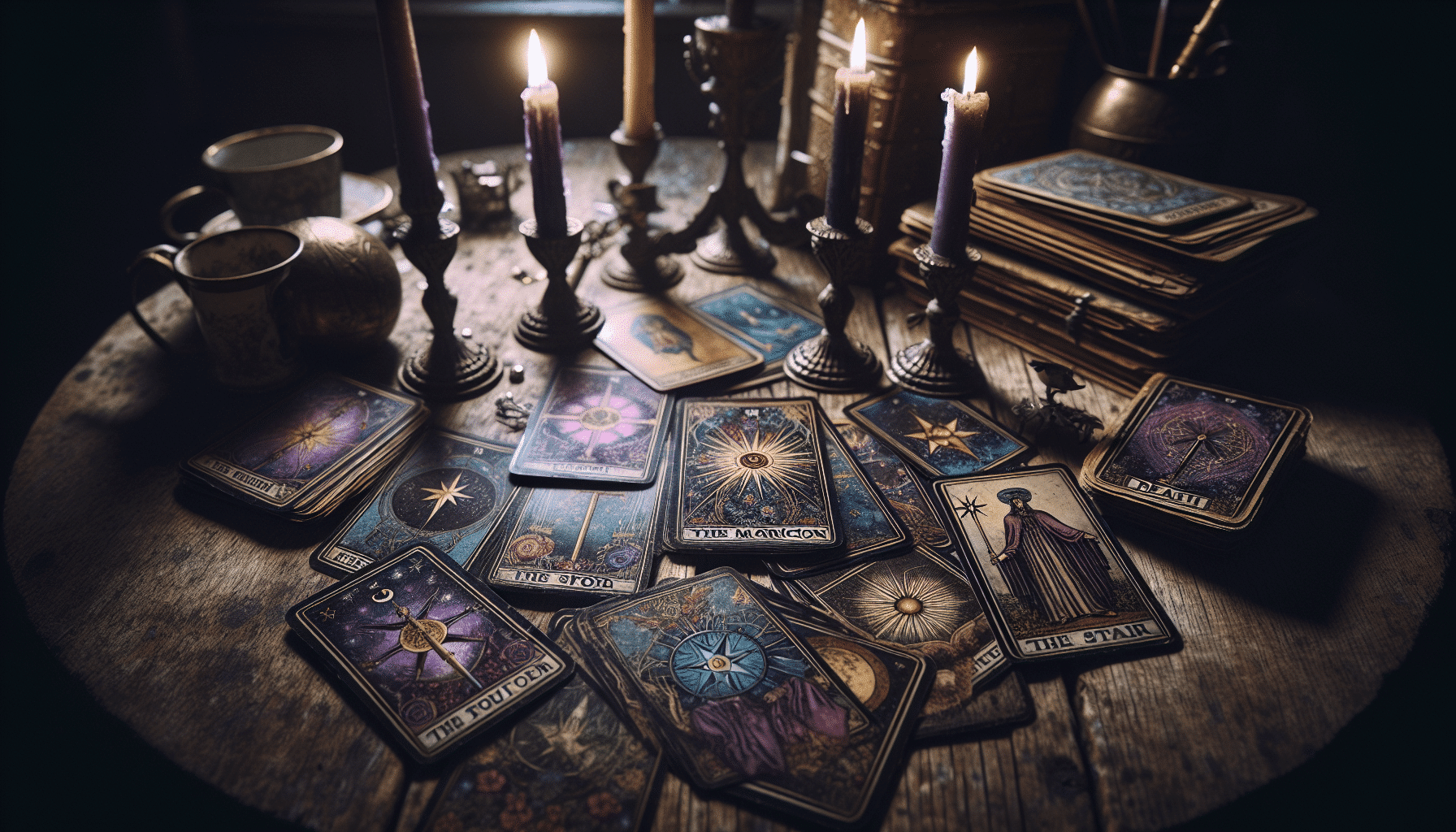
Theosophy, a mystical religious movement, played a pivotal role in the late 19th-century revival of interest in Tarot as a tool for divination and spiritual insight. As you explore the esoteric art woven into each Tarot card, you’ll notice symbols and themes that resonate deeply with Theosophical teachings.
Theosophists’ fascination with ancient wisdom and their quest to uncover the underlying truths of the universe dovetailed with Tarot’s rich tapestry of archetypal images and mystical motifs.
You’ll find that the Theosophical Society, founded in 1875, became a crucible for modern divination practices. Its members, seeking a direct experience of the divine, saw Tarot as more than a game; they considered it a profound method for self-exploration and accessing higher knowledge. Influential figures within the movement, such as Helena Blavatsky, contributed to the re-enchantment of Tarot by infusing it with their spiritual ideologies and by emphasizing its potential as a tool for enlightenment.
As you delve into the Tarot’s history, you’ll understand that the Theosophical influence helped transition the cards from parlor amusements to powerful mediums for personal growth and esoteric study. This shift in perception laid the groundwork for Tarot’s enduring popularity in spiritual and metaphysical circles today.
Modern Tarot and Mystical Trends
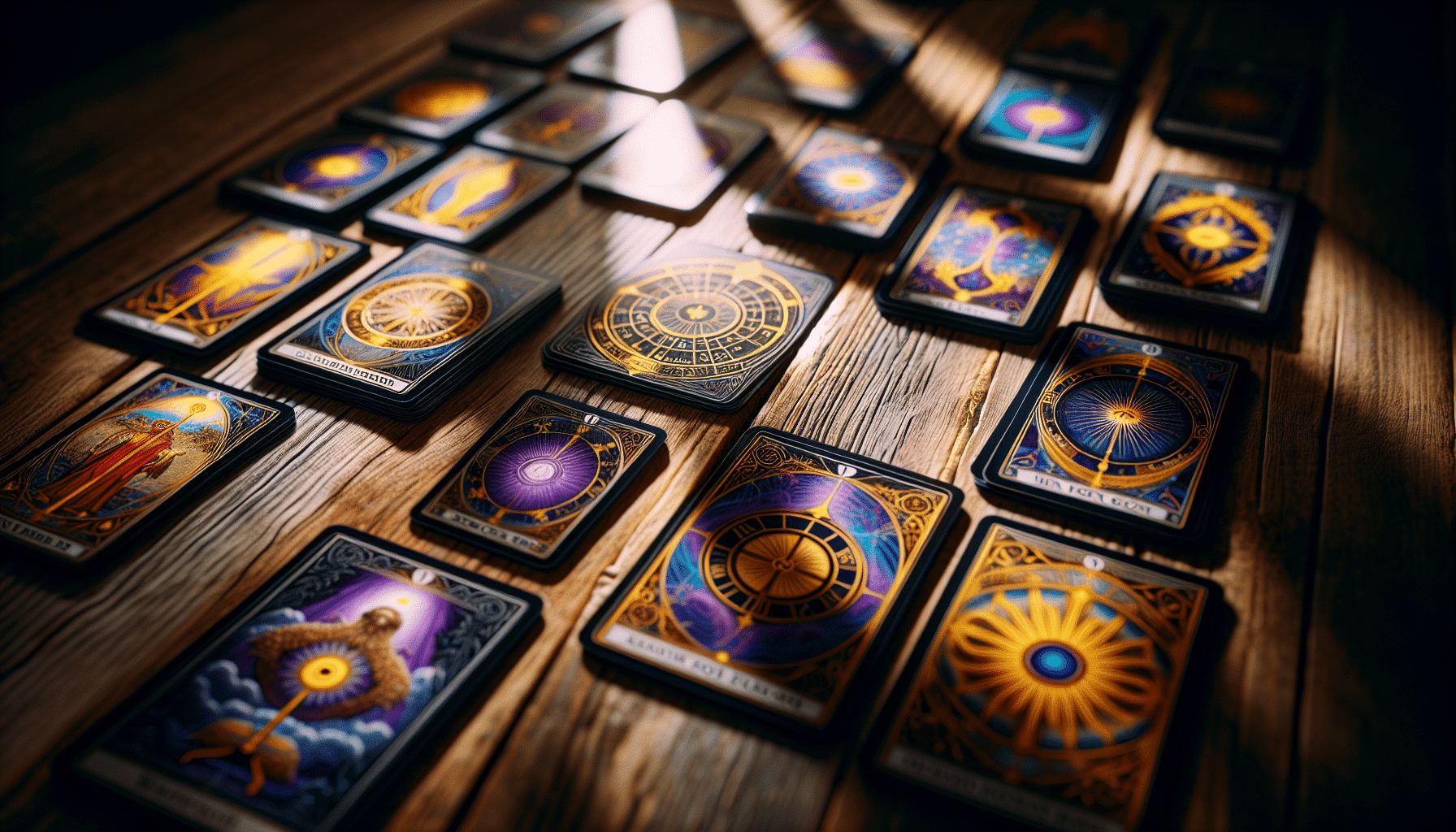
You’ve seen how tarot’s renaissance was intertwined with the rise of Theosophy, but let’s turn to how today’s spiritual movements continue to shape tarot’s evolution.
Mysticism hasn’t just left its mark in the past; it’s actively forging the path of modern tarot practice. As you explore this journey, consider how contemporary mystical trends breathe new life into these age-old cards.
Contemporary Spiritual Movements
Many modern spiritual seekers have turned to tarot as a tool for personal guidance, intertwining it with various mystical traditions to enhance its interpretive depth.
You’re likely to find tarot decks infused with symbols from:
- New Age practices
- Holistic healing
- Astrological correspondences
-
Crystal energies
-
Pagan resurgence
- Goddess worship
- Nature-based spirituality
-
Celebrations of the Wheel of the Year
-
Diverse mystical systems
- Kabbalistic associations
- Sufi wisdom
- Eastern philosophies
These contemporary movements reflect a tapestry of belief systems that many find empowering. They offer a way to navigate life’s complexities, using tarot as a reflective mirror. You’re not just holding cards; you’re holding a convergence of ancient wisdom adapted for modern spiritual exploration.
Mysticism in Tarot Revival
Often, you’ll find that modern tarot decks are steeped in mysticism, reflecting a revival that intertwines ancient symbols with contemporary spiritual trends. As you delve deeper into tarot symbolism, it becomes clear that each card’s imagery is more than just art; it’s a gateway to understanding life’s mysteries through divination practices.
This blend of the old and the new caters to your desire for personal growth and self-reflection.
Mysticism hasn’t just influenced the imagery; it’s reshaped how you practice tarot reading today. You’re encouraged to tap into your intuition and seek a connection with the divine, or your higher self, making tarot a tool for spiritual guidance.
This modern approach to tarot allows you to explore mystical realms within a familiar, accessible framework.
Conclusion
You’ve journeyed through tarot’s mystical tapestry, where ancient wisdom and cosmic secrets intertwine like lovers’ fingers.
From its humble beginnings to the esoteric explosions of the Renaissance, tarot has been transformed into a beacon of personal insight.
Now, as you shuffle the deck of modern mysticism, remember that tarot’s evolution is a mirror to our unquenchable thirst for the divine, a thirst so profound it could fill the oceans of the subconscious.
Keep seeking, and let the cards guide you.
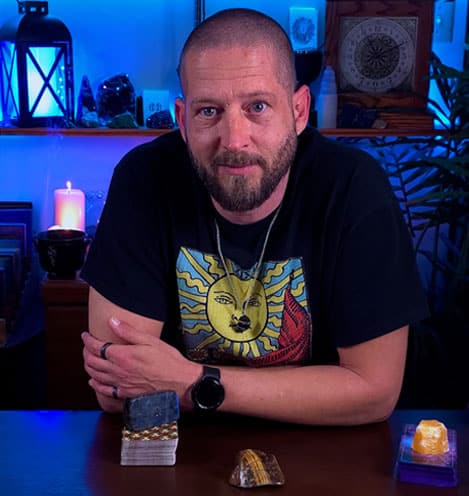
About The Author – Allen Hill
Allen Hill, the force behind Unknown Truth Tarot, has a YouTube following 6-times bigger than the population of his hometown, Miamisburg, Ohio. From his spiritually rich blog on Tarot and crystals to his role as CEO of The Unknown Truth Tarot Metaphysical Shop, Allen’s passion for the metaphysical shines through.
A master Tarot reader and “crystal junkie,” Allen is also a devoted dad to Dylan, 10, and Destiny, 24. When he’s not immersed in the world of Tarot and crystals, he enjoys poker and video gaming sessions, often humorously outplayed by Dylan.
Follow Allen on Twitter, Instagram, Facebook, TikTok, and subscribe to his Unknown Truth Tarot YouTube channel to join him on a journey of spiritual growth and self-discovery.

